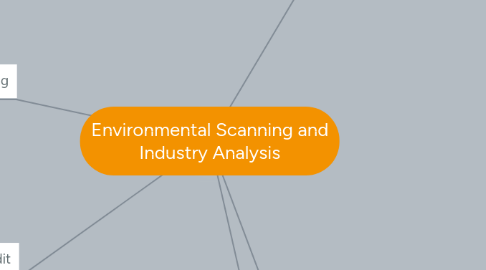
1. Forecasting
1.1. Forecasting Techniques
1.1.1. Extrapolation
1.1.2. Brainstorming
1.1.3. Expert opinion
1.1.4. Statistical Modeling
1.1.5. Prediction markets
1.1.6. Scenario writing
1.1.7. Cross-impact analysis
1.1.8. Trend impact analysis
1.1.9. Delphi technique
2. Strategic Audit
3. Environmental Scanning
3.1. Definitions
3.2. External Environment Variables
3.2.1. Natural environment
3.2.1.1. Physical Resources
3.2.1.2. Wildlife
3.2.1.3. Climate
3.2.2. Societal Environment
3.2.2.1. Economic forces
3.2.2.2. Technological forces
3.2.2.3. Political-legal forces
3.2.2.4. Sociocultural forces
3.2.3. Remote Environment
3.2.3.1. Economic fabric
3.2.3.2. Political and legal factors
3.2.3.3. Social and demographic features and trends
3.2.3.4. Technology
3.2.3.5. Physical environment
3.2.4. Immediate or Task Environment
3.2.4.1. Customers and potential customers
3.2.4.2. Competitors
3.2.4.3. Labor forces/ unions
3.2.4.4. Suppliers
3.2.4.5. Creditors
3.2.4.6. Regulation agencies
3.3. Strategy Development Process
3.3.1. Approaches and Methods
3.3.2. Strategic Thinking
3.3.2.1. Options
3.3.3. Strategic Decision Making
3.3.3.1. Decisions
3.3.4. Strategic Planning
3.3.4.1. Actions
3.4. Generic Foresight Process
3.4.1. Inputs
3.4.2. Foresight
3.4.2.1. Analysis
3.4.2.2. Interpretation
3.4.2.3. Prospection
3.4.3. Outputs
3.4.4. Strategy
3.5. Aims and Purposes
3.5.1. Strategy Formulation
3.5.1.1. Mission
3.5.1.2. Objectives
3.5.1.3. Strategies
3.5.1.4. Policies
3.5.2. Strategy Implementation
3.5.2.1. Programs
3.5.2.2. Budgets
3.5.2.3. Procedures
3.5.3. Evaluation and Control
3.5.3.1. Performace
4. Industry Analysis
4.1. Forces Driving Competition
4.1.1. Threat of new entrants
4.1.2. Rivalry among existing firms
4.1.3. Threat of substitute products and services
4.1.4. Barganing power of buyers
4.1.5. Bargaining power of suppliers
4.1.6. Relative power of other stakeholders
4.1.6.1. Governments
4.1.6.2. Local communities
4.1.6.3. Creditors
4.1.6.4. Trade associations
4.1.6.5. Special interest groups
4.1.6.6. Unions
4.1.6.7. Shareholders
4.1.6.8. Complementors
4.2. Industry Evolution
5. Competitive Intelligence
5.1. Sources
5.1.1. Outside Organizations
5.1.2. In-house Libraries
5.1.3. Internet
5.1.4. Corporate and industrial espionage
